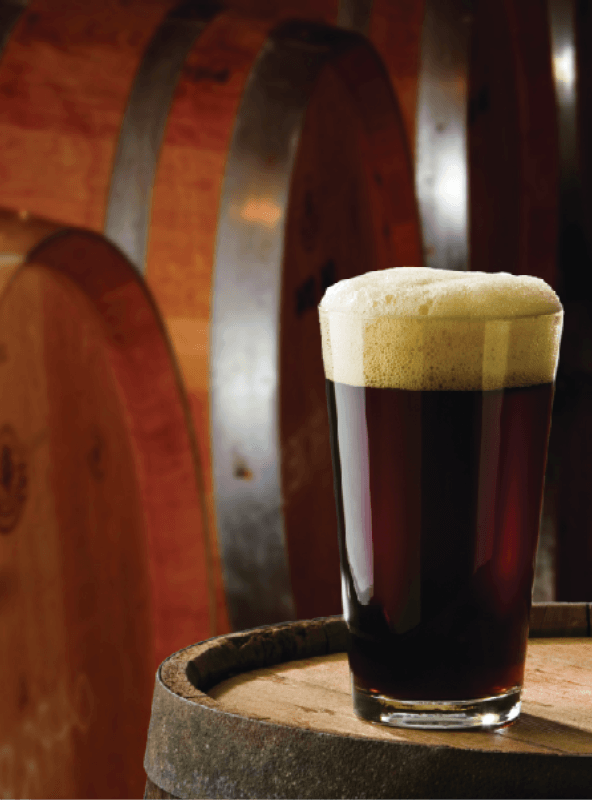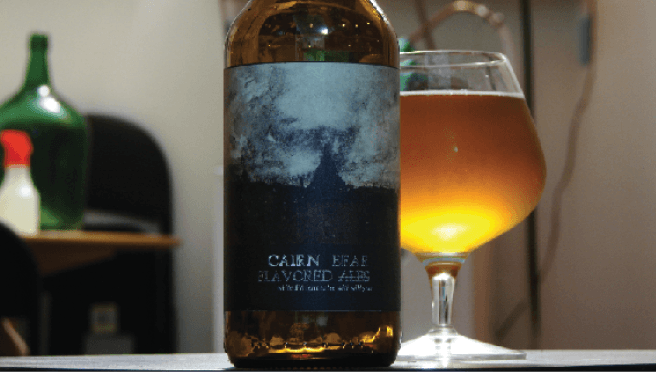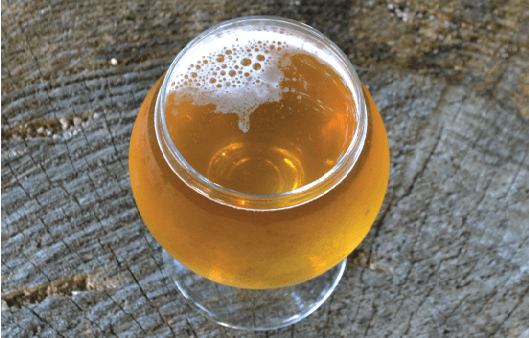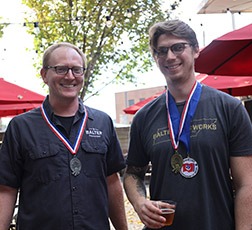Brewing All-Brett IPA

But I would like to issue a bit of a challenge to Mr. Pattinson, or any other beer historians, for there is a realm of beer that I believe has never bubbled inside any historic fermentation tank — those fermented exclusively with Brettanomyces. When it comes to 100% Brett-fermented beers, we may be dealing with the only style of beer truly invented by modern brewers during the craft beer revolution.
Most readers of BYO have probably heard the “British fungus” origins of Brettanomyces from its discovery in 1904 by N. Hjelte Claussen, at which point it became synonymous with the characteristics of aged beer. Historic brewers utilized Brettanomyces regularly, but unknowingly, and as a secondary fermenter during a beer’s long aging process. Brettanomyces tends to grow its numbers much slower than familiar Saccharomyces strains (a fact that’s important to note when building up your yeast starter, as we’ll get to later in this story.) Without modern yeast isolation techniques, Brettanomyces would soon fall behind other competing strains, reduced to its natural state as a scavenger alongside bacteria and other wild yeast — an important component of beer character, but not the sole primary fermenter.
The knowledge and technology to base a recipe exclusively around Brettanomyces possibly didn’t exist until recent decades. Is it impossible that some remote farmhouse brewery in a valley of Lithuania happened upon a pure-culture Brettanomyces strain, aggressive enough to dominate the competition and win out generation after generation? Certainly not — while thus far undocumented, anything is possible. If such a case were to be found, it would make for a fascinating chapter in the history of yeast culturing. (And personally, I would be ecstatic to see my humble challenge shot down.) Until then, it’s all the more reason to celebrate the boon of modern yeast culturing techniques.
Our knowledge is a gift granted to modern brewers, and with the power to harness wondrous new strains of yeast, we are only now learning what to do with them. As newly-discovered and surprisingly versatile strains of Brettanomyces slip out of their oaken Belgian breeding grounds, onto the agar plates of intrepid yeast ranchers, and into the vials of brewers across the world, never-before-seen styles like Brett IPA are finding their place.
Gimmicky Experiment or Noble Explorer?
The first question you should ask is: Why? Fermenting a beer entirely with Brettanomyces would be no more than a fascinating science experiment if the results were not delicious.
Given the number of unknown yeast floating around in the wild, Brettanomyces presents a very wild frontier, but many of the strains available commercially today are capable of producing flavorful, aromatic beers — beers that can stand apart from their domesticated cousins without opening up the full barnyard. Some Brettanomyces strains favor phenolics, but others will create suggestions of exotic tropical fruit that are perfect to pair with today’s popular hop varieties.
And as Brettanomyces can act as an oxygen-scavenger during aging, a Brett-fermented IPA will seem to remain fresh and vibrant longer than its peers. Many Brett strains offer high attenuation when given the opportunity for a healthy, vigorous fermentation. Building up a starter is vital, however, and should be done at least a week in advance, as Brett is slower to grow than its cousin Saccharomyces. Use lager rates, rather than ale pitching rates, when fermenting with strains like White Labs Brett Trois, and you will see a fermentation that wraps up in three weeks — not the eight months you might expect. (Be sure, however, that your fermentation has truly stopped before bottling to prevent explosions and gushers.) Brett is also more forgiving when it comes to warmer fermentation temperatures. A range between 68 °F and 74 °F (20 and 23 °C) should result in a clean fermentation, though cross too far below that threshold — into the low 60s — and you risk putting the yeast to sleep.
Find Your Brett
Unlike straight-up sour beer, which can find sourness and bitterness clashing unpleasantly, Brett’s funk tends to play well with hops. It’s important to note that Brett rarely creates as intense of a flavor profile when used as a primary, 100% fermenter — those characteristics generally require a long secondary aging process alongside Saccharomyces to emerge (and, in fact, many speculate that the original India pale ale was infected and refermented by Brettanomyces during its voyage to India.) However, even as a primary yeast, Brett flavors can range from funky to spicy to fruity. Among the thousands of Brett strains lurking out in the wild, there’s all the variety of brewer’s yeast — and given the more sophisticated genetic makeup of Brettanomyces, probably more.
Matt Walsh, head brewer at Modern Times Beer in San Diego, California, has overseen the release of three Brett IPAs since the brewery opened in summer 2013. While the brewery’s first Brett IPA, Neverwhere, was based on a homebrew recipe from Michael Tonsmeire, Modern Times’ brewers have rolled with the concept ever since, branching out into new hop varieties and SRM shades. Despite that, Walsh says, Trois remains their ideal strain for the style, with an attenuation similar to California ale yeast that results in the dry, clean profile preferred for an IPA.
“The beers we fermented with [Trois] all had a common trait that we referred to as ‘juiciness’,” Walsh said. “Basically this ‘juiciness’ presented itself as perceived sweetness with notes of tropical and citrus fruits. Mango, pineapple, and guava being the most prominent.” Sound like flavors you might want in your next IPA?
Building Body, and Balance
With Brettanomyces adding a whole new dimension to a beer, brewers need to keep their IPA from tipping off-kilter in some unexpected direction. An overly rich malt base can become cloying faster than in a traditional resin-bomb IPA, with too many flavors playing against each other. Regardless, you won’t have to worry about keeping it light bodied. Brettanomyces cannot produce the compound glycerol, which adds to the perception of body in Saccharomyces-fermented ales. As a result, low-ABV, 100% Brett-fermented beers can feel watery without the right grain bill in place. A significant percentage of wheat or oats will help to counteract this thinness, as will a higher mash temp.
Jeff “Chief” O’Neil, former brewmaster at Ithaca Beer Co. and now-brewmaster for Peekskill Brewery in Peekskill, New York, was an early adopter of Brett IPA. After O’Neil pitched the idea of a 100% Brett fermented IPA as a collaboration with other New York-area breweries back in 2010, the beer known as Super Friends
IPA helped to define the style.
O’Neil’s most recent take on the style, the aptly named Awesome Sauce, pours as pale as any other IPA from Peekskill Brewery, but O’Neil also recommends making sure the Brett has enough to work with.
“I’ve found that making the malt bill a little more complex can give the Bretts a challenge, more than with a simpler recipe,” said O’Neil. “You might have to allow for an extra week of primary fermentation, but the trade-off can be a finished beer with more depth.”
Don’t Forget the Hops
Only when paired with something as potent as Brettanomyces could a discussion of IPA wait to address hops as a final factor. To be fair, the hop bill might be the easiest factor in formulating a Brett IPA recipe, especially if you already have a handle on a few favorite combinations. Hops are a familiar element compared to Brett, and a variety of approaches should all produce pleasing results.
For fans of explosively tropical IPAs, you won’t go wrong pairing two fruity elements together. However, keep in mind the alchemy induced by fermentation — Brett is notorious for rearranging flavor compounds, and hops don’t always come out the other end of a fermentation tasting like you remember. In other words, it’s easier to fit a beer around Brett than it is to fit Brett into a beer. In my experience, Brett overwrites much of the flavor from high-impact flavor hops used in the boil, and I’ve begun focusing on aggressively dank/fruity combos like Columbus, Centennial and Citra® to make sure they shine through. If you want to make sure you get every dollar’s worth out of that ounce of Amarillo®, push more of your hops to the dry-hop stage, after fermentation has finished and much of the Brett has flocculated out.
This, too, will favor a less bitter IPA — perfect for a light and fruity beer. O’Neil believes that bitterness can be dialed back significantly to maintain balance in this rearranged style. “Given enough time, the fermentation will be more complete than with an ale yeast, and this drier beer will need less bitterness to achieve balance,” he said.
Walsh notes that Modern Times bitters primarily with hop extract, and keeps the kettle hopping conservative. “We do fairly heavy dry-hopping to complement or contrast with the tropical notes of the Brett,” he said. As for hops: “Citra®, Centennial, Motueka and Calypso have been the main players so far.”
New Yeast, New Potential
Almost every season sees the major yeast companies promote special-edition yeast strains and blends, usually based around brewing styles for the coming weather. But it’s not often homebrewers are offered a brand new strain of Brettanomyces — in previous decades, few strains were commonly known or used beyond the classic bruxellensis, lambicus, and claussenii. That changed in 2012 when White Labs released Brettanyomces bruxellensis Trois (WLP644) as a Platinum strain, then quickly brought it back at the beginning of 2013 as a new year-round offering. The release was a landmark moment for brewers of the funk.
Chris White, founder, president, and CEO of White Labs, reports that Trois came to White Labs through a “well-known” sour production brewery in the US, after originally being acquired from Belgium. Previously known as Brett Drei (and yes, the recurring “3” motif is a hint as to its origin), the strain was already popular with pioneering Brett brewers like Crooked Stave’s Chad Yakobson.
“A new strain is tested for many different things once we receive it,” White said. “The most important factors we’re looking at are performance, desirable flavor, aroma characteristics, and uniqueness. This involves performing both multiple lab-scale fermentation trials, as well as 5-gallon (19-L) trials at our small onsite brewery. The process takes months.”
White Labs found that the sensory profile of Trois, as well as its performance as a primary yeast, made it a strain deserving of close attention.
“Because of its vigorous performance rates, it has a faster turnaround time for fermentation than some of the other Brett strains available,” White added. “The flavor profile it provides is tart without being overly solventy or phenolic/band-aidy.”
Ready to make your own history by brewing this exciting new style in your homebrewery? Check out the two Brett IPA recipes below!
 Cairn 100% Brett IPA
Cairn 100% Brett IPA
(5 gallons/19 L, all-grain)
OG = 1.057 FG = 1.010
IBU = 62 SRM = 5 ABV = 6.2%
Ingredients
7.25 lbs. (3.3 kg) 2-row pale malt
3.5 lbs. (1.6 kg) white wheat malt
1 lb. (0.45 kg) Weyermann Carahell® malt
4.3 AAU Northern Brewer hops
(60 min.) (0.5 oz./14 g at 8.5% alpha acids)
28 AAU CTZ hops (0 min.)
(2 oz./57 g at 14% alpha acids)
10 AAU Centennial hops (0 min.)
(1 oz./28 g at 10% alpha acids)
2 oz. (57 g) Centennial hops (dry hops)
2 oz. (57 g) Citra® hops (dry hops)
½ tsp. yeast nutrient (15 min.)
1 tsp. Irish moss (15 min.)
White Labs WLP 648 (Brettanomyces bruxellensis Trois Vrai) or White Labs WLP644 (Saccharomyces “Bruxellensis” Trois) yeast
2⁄3 cup (140 g) corn sugar (for priming)
Step by Step
Mill the grains and dough-in with 15 qts. (14 L) water, for a mash ratio of about 1.25 quarts per pound of grain. Target a mash temperature of 155 °F (68 °C) and hold for 60 minutes. Sparge with 170 °F (77 °C) water. Collect approximately 6.3 gallons (23.8 L) of wort runoff and bring to boil. Add bittering hops and boil for 60 minutes. After adding the 0-minute hop additions, turn off heat and let steep for half an hour before you begin cooling the wort. This “whirlpool” hop addition can be calculated as somewhere between a 10–5 minute addition for alpha acid utilization. Pitch a 2 qt. (2 L) yeast starter and ferment at 68–72 °F (20–22 °C). Fermentation should take two to three weeks, but keep an eye on your gravity. Following fermentation, dry hop for one week, then bottle or keg.
Cairn 100% Brett IPA
(5 gallons/19 L, extract with grains)
OG = 1.060 FG = 1.013
IBU = 60 SRM = 6 ABV = 6.2%
Ingredients
6.6 lbs. (3.0 kg) Pilsen light liquid malt extract
1 lb. (0.45 kg) wheat dried malt extract
12 oz. (0.34 kg) crystal malt (20 °L)
4.3 AAU Northern Brewer hops
(60 min.) (0.5 oz./14 g at 8.5% alpha acids)
28 AAU CTZ hops (0 min.)
(2 oz./57 g at 14% alpha acids)
10 AAU Centennial hops (0 min.)
(1 oz./28 g at 10% alpha acids)
2 oz. (57 g) Centennial hops (dry hops)
2 oz. (57 g) Citra® hops (dry hops)
½ tsp. yeast nutrient (15 min.)
1 tsp. Irish moss (15 min.)
White Labs WLP 648 (Brettanomyces bruxellensis Trois Vrai) or White Labs WLP644 (Saccharomyces “Bruxellensis” Trois) yeast
2⁄3 cup (140 g) corn sugar (for priming)
Step by Step
Steep the crushed grain in 2.0 gallons (7.6 L) of water as it warms until a temperature of about 150 °F (65.5 °C) is reached, or approximately 20 minutes. Remove grains from the wort and rinse with 4.0 quarts (3.7 L) of hot water. Add the liquid to reach a total of 3 gallons (11.3 L) and bring to boil. Turn off heat, add malt extract, and stir until completely dissolved. Return to heat and add 60 minute hop addition, then continue boil for 60 minutes. At flameout, add final hop additions and turn off heat. Let hops steep (whirlpool) for 30 minutes before cooling.
Cool the wort to 72 °F (22 °C), then top off with cold, filtered water to reach 5 gallons (19 L). Pitch 2 qts (2 L) yeast starter and ferment at 68–72 °F (20–22 °C). Fermentation should take two to three weeks, but keep an eye on your gravity. Following fermentation, dry hop for one week, then bottle or keg.
Modern Times Southern Lands IPA clone
(5 gallons/19 L, all-grain)
OG = 1.065 FG = 1.008
IBU = 60 SRM = 5 ABV = 7.8%
Ingredients
10.7 lbs. (4.9 kg) 2-row pale malt
2 lbs. (0.9 kg) white wheat malt
6.4 oz. (0.18 kg) acidulated malt
6.4 oz. (0.18 kg) dextrine malt
2 oz. (57 g) crystal malt (60 °L)
3 ml HopShotTM extract (60 min.) (~30 IBU)
20 AAU Centennial hops (1 min.)
(2 oz./57 g at 10% alpha acids)
14 AAU Calypso hops (1 min.)
(1 oz./28 g at 14% alpha acid)
2 oz. (57 g) Centennial hops (dry hops)
1.5 oz. (43 g) Calypso hops (dry hops)
½ tsp. yeast nutrient (15 min.)
1 Whirlfloc tablet (15 min.)
White Labs WLP644 (Brettanomyces bruxellensis Trois) yeast
2⁄3 cup (140 g) corn sugar (for priming)
Step by Step
Mill the grains and dough-in with 16 qts (15 L) water, for a mash ratio of about 1.25 quarts per pound of grain. Target a mash temperature of 156 °F (68.8 °C) and hold for 60 minutes. Sparge slowly with 170 °F (77 °C) water. Collect approximately 6.3 gallons (23.8 L) of wort runoff and bring to boil. Add bittering hops and boil for 60 minutes. After boil, add flameout hops and whirlpool for 30 minutes before cooling. Cool to room temp, pitch yeast and ferment at 68–72 °F (20–22 °C). Dry hop for seven days before bottling or kegging.
Modern Times Southern Lands IPA clone
(5 gallons/19 L, extract with grains)
OG = 1.065 FG = 1.010
IBU = 60 SRM = 5 ABV = 7.4%
Ingredients
3.3 lbs. (1.5 kg) Pilsen light liquid malt extract
3 lbs. (1.4 kg) golden light driedmalt extract
1.5 lb. (0.68 kg) wheat dried malt extract
4 oz. (0.11 kg) crystal malt (60 °L)
3 ml HopShotTM extract (60 min.) (~30 IBU)
20 AAU Centennial hops (1 min.)
(2 oz./57 g at 10% alpha acids)
14 AAU Calypso hops (1 min.)
(1 oz./28 g at 14% alpha acid)
2 oz. (57 g) Centennial hops (dry hops)
1.5 oz. (43 g) Calypso hops (dry hops)
½ tsp. yeast nutrient (15 min.)
1 Whirlfloc tablet (15 min.)
White Labs WLP644 (Brettanomyces bruxellensis Trois) yeast
2⁄3 cup (140 g) corn sugar (for priming)
Step by Step
Steep the crushed grain in 2 gallons (7.6 L) of water as it warms to about 150 °F (65.5 °C) is reached, or approximately 20 minutes. Remove grains from the wort and rinse with 4 qts. (3.7 L) of hot water. Add the liquid to reach a total of 3 gallons (11.3 L) and bring to boil. Turn off heat, add malt extract, and stir until completely dissolved. Return to heat and add 60-minute hop addition, then boil for 60 minutes. At flameout, add final hop additions and turn off heat. Let hops steep (or whirlpool) for 30 minutes. Cool the wort to room temperature, then top off with cold, filtered water to reach 5 gallons (19 L). Pitch yeast and ferment at 68–72 °F (20–22 °C). Dry hop for seven days before packaging.

Brett IPA Commercial Examples
3767 Belgian-style IPA
Midnight Sun Brewing Co.
Anchorage, Alaska
www.midnightsunbrewing.com
Brett Liquor IPA
Surly Brewing Co.
Brooklyn Center, Minnesota
www.surlybrewing.com
Eight Point IPA
Devils Backbone Brewing Co.
Roseland, Virginia
www.dbbrewingcompany.com
Femme Fatale Brett
Evil Twin Brewing
København, Denmark
www.amsterdambeer.com
Mikkeller Brett IPA
Mikkeller
Copenhagen, Denmark
www.mikkeller.dk
Neverwhere
Modern Times Beer
San Diego, California
www.moderntimesbeer.com
Southern Lands
Modern Times Beer
San Diego, California
www.moderntimesbeer.com
Super Friends IPA
Ithaca Beer Company
Ithaca, New York
www.ithacabeer.com
Wicked Weed Brett IPA
New Belgium Brewing Co. with Wicked Weed Brewing
Asheville, North Carolina
www.wickedweedbrewing.com
Wild Devil
Victory Brewing Company
Downingtown, Pennsylvania
www.victorybeer.com
W.W.B.G
Crooked Stave Artisan
Beer Project
Denver, Colorado
www.crookedstave.com
Note: Not all examples are 100% Brett

 Cairn 100% Brett IPA
Cairn 100% Brett IPA


